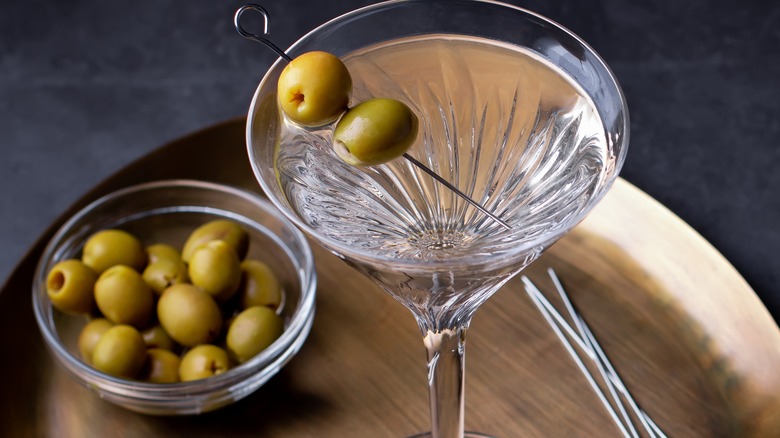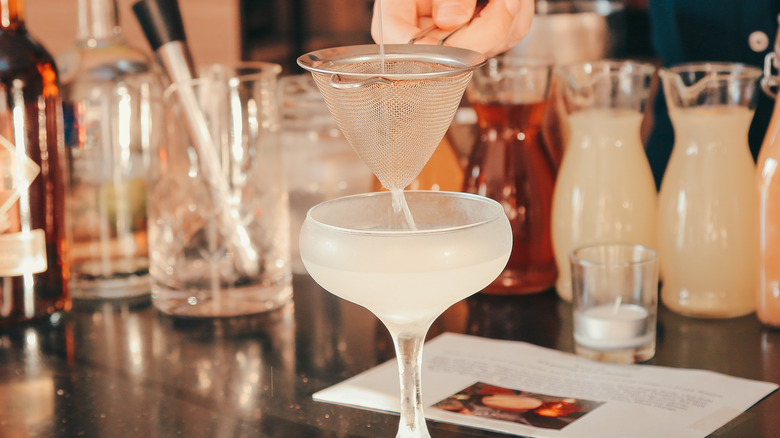How To Order The Perfect Martini With Confidence
Oh, the martini. No other drink says, "I'm equal parts class and badass," and does so in such a sleek-looking way. Sure, the cosmopolitan had its day (thank you, "Sex and the City"), but the martini is truly iconic. World leaders like Winston Churchill and JFK claimed it as a favorite, as did filmmaker Alfred Hitchcock. Writer Ernest Hemingway, who "liberated" the bar at the Ritz Paris from the Germans during WWII, loved martinis so much that after this so-called liberation, he proceeded to consume more of them than any human before or after (51!) — or so the story goes (via The Jakarta Post). And, even if you've never seen a James Bond film, you've probably heard the fictional character's most-notable line: "Vodka martini; shaken, not stirred," which is actually the wrong way to make a martini, according to The Guardian. Martinis shouldn't be shaken.
No matter how you slice it, the martini is special. And, if you ask any martini drinker, they'll tell you that how you order it can say a lot about you. Because of this, you absolutely want to know what you're doing when you mosey on up to the bar.
Know what you're getting yourself into
Although a martini can be made with gin or vodka, the more traditional method is with gin. This dates back to the United States' prohibition era when moonshine could be easily masked with juniper berries, then mixed with other ingredients such as vermouth, to make the alcohol drinkable (via USA Today). When prohibition ended and "bathtub gin" evolved into tastier alcohol that needed less masking, the gin martini we know today was born.
If you're not a fan of gin, there's vodka. Some people just can't stomach a drink that smells like a pine tree and would rather have something less, well, piney. The vodka or gin is combined with vermouth — a must when it comes to martinis — and then finished with a garnish. The classic martini is usually garnished with an olive, but that doesn't mean you can't request a twist (a citrus peel) or even an onion.
"Here's a pro tip," Edwin Cruz, beverage director at Winsome in Los Angeles, tells Thrillist. "If you want a gin martini with onion it's called a Gibson. The garnish on a martini is meant to enhance or feature the aspect you like most about the gin or vodka, and vermouth. If you like savory, go for an olive or onion. If you want to bring out the bright clean citrus or floral notes, go for a twist. Don't be afraid to consult your bartender on which option will work best for your spirit of choice."
Know how you want it made
Unless you specify you want it "on the rocks," meaning over ice, martinis are traditionally served "up," meaning no ice (via The Sip Blog). A proper martini is served in a cold glass so there's really no need for ice. While "up" means no ice, it's important to note that "straight-up" means no vermouth, so you're going to be served a glass of straight vodka or gin with a garnish. While you can order your martini as you want, without the vermouth, you're technically not drinking a martini.
When it comes to shaken or stirred, traditionalists will say a martini should never be shaken. Reasons for this is potential "bruising" of the alcohol and the effect the ice in a shaker can have on the drink as a whole. "[Stirred] results in a smoother version, with less likelihood of ice shards in your cocktail," Allen Katz, the director of Mixology and Spirits Education for Southern Wine & Spirits of New York, tells Business Insider.
Although a recent survey by Elit Vodka found that 20% of martini drinkers prefer their cocktails dirty, meaning made with olive juice, and 19% prefer a dry martini, meaning less vermouth, you may find yourself in a category all your own. The perfect martini is the one you want to drink. As long as you have the terminology down and know what you like, you can roll into any bar and order a martini with total confidence.


